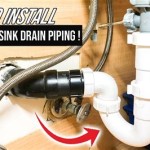Installing A Kitchen Sink Drain
Installing a kitchen sink drain is a manageable plumbing project for the DIY enthusiast. A successful installation requires careful preparation, the right tools, and attention to detail. This guide will walk through the process step-by-step, ensuring a leak-free and properly functioning drain.
Gathering Necessary Tools and Materials
Before beginning the installation, it's crucial to gather all the necessary tools and materials. This preemptive step will streamline the process and prevent unnecessary interruptions. Essential tools include adjustable pliers, plumber's putty, a basin wrench, a utility knife, and a screwdriver. Materials will include a new sink drain assembly (typically containing a strainer basket, tailpiece, P-trap, and various nuts and washers), PVC or ABS pipe and fittings for the drain lines, and pipe sealant.
Choosing the right drain assembly depends on the sink configuration. A standard basket strainer assembly is common for most kitchen sinks. Ensure the assembly matches the existing drain opening size and the sink material. Opting for high-quality materials, such as stainless steel, can enhance durability and longevity.
Preparing the Sink and Workspace
Once the necessary tools and materials are assembled, preparation of the sink area is the next step. First, turn off the water supply to the sink. This is crucial to prevent any accidental flooding during the installation process. Next, place a bucket or container under the existing drain assembly to catch any residual water. Remove the old drain assembly by loosening the slip nuts connecting the P-trap to the drain pipes and the tailpiece to the strainer basket. Thoroughly clean the sink drain opening, removing any old putty or sealant.
Protecting the sink surface is important during the installation. Placing a cloth or towel around the sink opening can prevent scratches or damage from tools. Having ample lighting is also beneficial for clear visibility throughout the installation process.
Installing the New Drain Assembly
Begin installing the new drain assembly by applying a generous ring of plumber's putty around the underside of the strainer basket flange. Insert the strainer basket into the drain opening from above. From below the sink, tighten the locknut onto the strainer basket, securing it in place. The excess putty will squeeze out from around the flange; remove this excess with a putty knife or damp cloth for a clean finish.
Next, install the rubber washer and friction ring onto the tailpiece. Insert the tailpiece into the strainer basket from below and tighten the nut to secure it. Be careful not to overtighten, as this could damage the components. Apply pipe sealant to the threads of the slip nuts on the P-trap assembly.
Connect the P-trap to the tailpiece and the drain pipe, tightening the slip nuts by hand. Then, use pliers to give the nuts a final quarter turn to ensure a watertight seal. Avoid overtightening, as this can crack the plastic nuts or damage the pipes. Once the drain assembly is in place, turn the water supply back on slowly and check for any leaks.
Connecting the Drain Lines
Depending on the existing plumbing configuration, the drain lines may require adjustments or replacement. If connecting to existing PVC or ABS pipes, measure and cut the pipes to the appropriate length using a pipe cutter or hacksaw. Ensure clean, square cuts for optimal connections. Apply pipe sealant to the pipe ends and connect the fittings, ensuring they are properly aligned. Use pliers to tighten the slip nuts on the pipe fittings, again avoiding overtightening.
When working with drain lines, it's crucial to maintain the correct slope or pitch. This ensures proper drainage and prevents water from pooling in the pipes. A general guideline is a ¼-inch drop per foot of horizontal run. Use a level to verify the proper slope during installation.
Testing for Leaks and Final Adjustments
After all connections are made, the final step is to thoroughly test for leaks. Fill the sink with water and observe all connections for any signs of dripping or seepage. If a leak is detected, tighten the corresponding connection slightly. If the leak persists, disassemble the connection, clean the surfaces, and reapply pipe sealant before reassembling. Run the garbage disposal, if applicable, to verify proper drainage and ensure no obstructions.
Periodically inspect the drain assembly and connections for leaks or signs of wear. Regular maintenance can prevent future problems and extend the lifespan of the drain assembly. Knowing how to install a kitchen sink drain can save time and money, and empower homeowners to handle common plumbing tasks with confidence.
How To Install A Kitchen Sink Drain

How To Install A Kitchen Sink Drain Diy Guide For You

How To Replace A Kitchen Sink Basket Strainer Diy Family Handyman

How To Install A Kitchen Sink Drain With Pictures Wikihow
How To Install A Kitchen Sink Drain

How To Install Kitchen Sink Drain Strainer Stop Leaks

How To Install Kitchen Sink Drain Strainer Stop Leaks Youtube

How To Install A Kitchen Sink Drain With Pictures Wikihow

How To Easily Connect The Plumbing For A New Bathroom Sink Hometips

Kitchen Sink Plumbing How To Make A Drain Better







